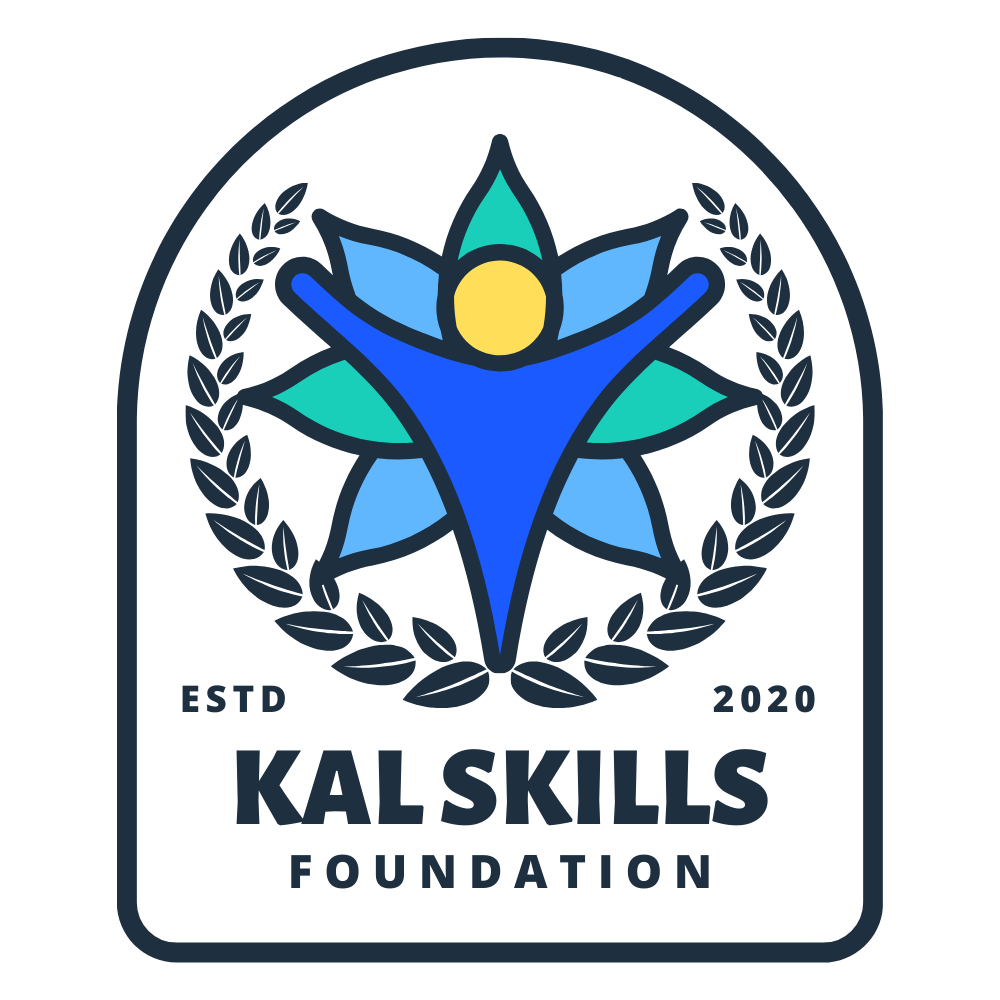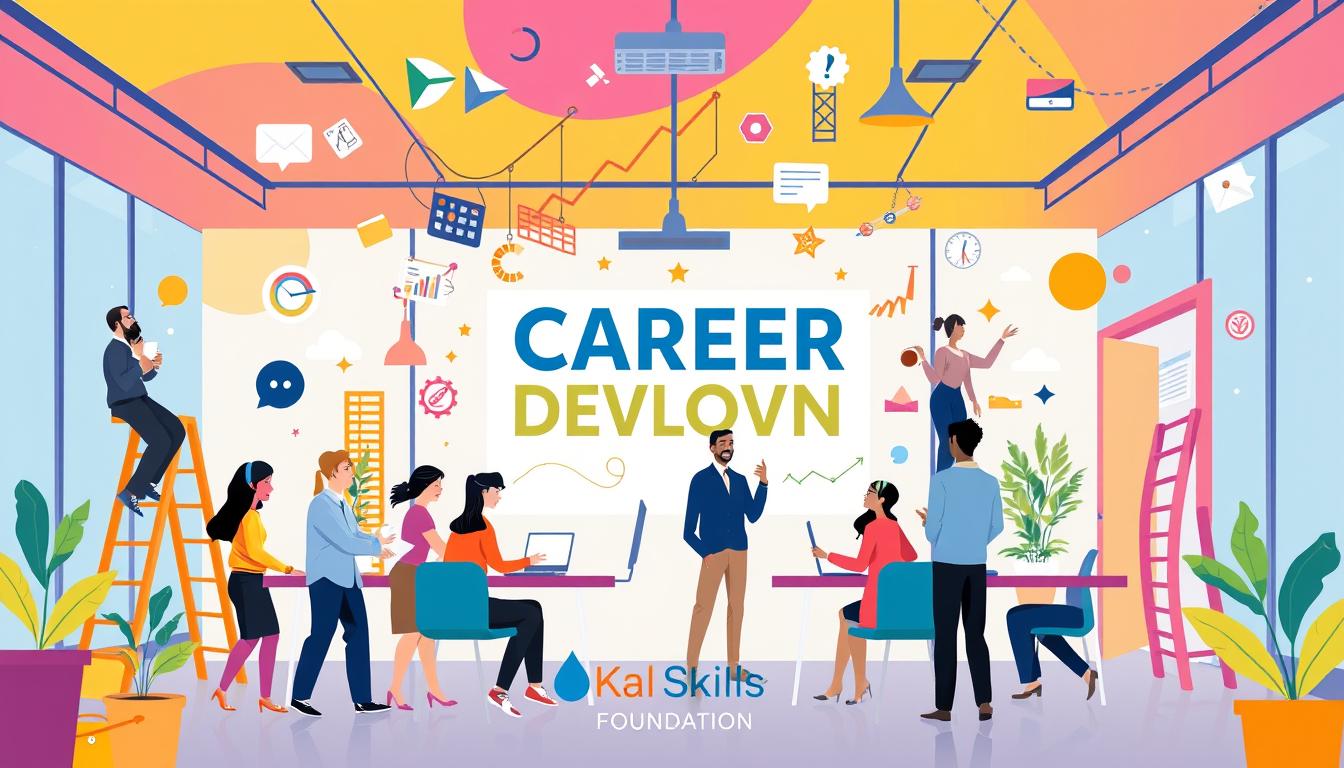Have you thought about how a skilled workforce could change India’s economy and the global job market? With over 65% of the population under 35, preparing this young group with the right skills is urgent1. The Skilled India initiative aims to close the gap between current talent and the skills needed for new industries. It’s clear that India needs 103 million skilled workers, but only 74 million are available2.
This huge gap shows the need for more investment in skill development. It also highlights the chance for big economic growth. As jobs change with automation and globalization, India’s skilled workforce is key to becoming a global leader.
Key Takeaways
- The youthfulness of India’s workforce is critical to its economic potential.
- There’s a significant gap in skilled workers needed for various emerging sectors.
- Government initiatives aim to align skill training with industry needs.
- Investment in skill development is key to tackling unemployment.
- Collaboration between educational institutions and industries enhances job readiness.
- Future skills development encompasses both technical and soft skills.
The Importance of Skill Development in India
Skill development is key to India’s economic growth. It boosts employability and productivity. With 28 million young people joining the workforce each year, India needs skilled workers more than ever.
This importance goes beyond just jobs. Skilled workers drive innovation and efficiency across different sectors. They play a big role in the country’s economic growth.
Economic Growth through Skills
In India, only 10% of recent graduates have the skills for corporate jobs. This leaves 90% struggling to find work3. This skills gap hurts both individual careers and the national economy.
The government wants to make 70% of the workforce employable through skill development. This is a big step to address the lack of highly-trained labor4.
As technology advances, companies need workers who can adapt. Skilled workforce training helps with this, making companies more competitive and productive4. It also makes workers happier and reduces turnover, boosting corporate morale and efficiency5.
India’s economy is set to grow, with a GDP of $5 trillion by 20253. But to reach this goal, India needs more skilled workers and better talent development systems. By empowering people with the right skills, India can turn its demographic advantage into economic growth4.
Current Landscape of the Skilled Workforce in India
The skilled workforce in India shows both opportunities and challenges. By 2022, India aims to have 500 million skilled workers. Yet, 12 million new workers will join each year6. Only 25% of professionals are ready for jobs in the organized sector, showing big skill development hurdles7.
Analyzing Existing Skills
Jobs will grow in Auto and Auto Components, Tourism, IT, Healthcare, and Education6. But, there’s a talent gap. Only 3.4 million graduates from ITI/ITC, BE, and Polytechnics are available6.
Big companies like TCS and Infosys are training their workers7. NGOs are also helping with vocational training and digital skills7. Learning institutions and industries are working together, like IIT Madras with tech firms7.
Government Initiatives Driving Skill Development
The Indian government has taken big steps to boost skill development. They launched the Skill India Mission to make youth more employable. This mission aims to match young people’s skills with what modern industries need.
The landscape of skill development programs India is always changing. It’s designed to fill the skill gaps in the economy.
Key Programs and Policies
Programs like the Pradhan Mantri Kaushal Vikas Yojana (PMKVY) and the National Apprenticeship Promotion Scheme (NAPS) are getting a lot of attention. Women’s participation in long-term skilling programs in ITIs has grown from 9.8% in FY16 to 13.3% in FY24. This shows a focus on making sure everyone is included8.
The PMKVY has also made a big effort to include more women. The number of women trained under this scheme has gone up from 42.7% in FY16 to 52.3% in FY248.
The Skill India Digital Hub, launched in August 2023, has already signed up over 60 lakh learners8. Since NAPS started, it has engaged 32.38 lakh apprentices. This shows a lot of support and funding across different sectors8.
This platform works with big companies to train about 2.4 lakh delivery partners9.
The Craftsmen Training Scheme (CTS) has grown, showing the government’s commitment to helping more people, especially women. They are also working with many organizations and stakeholders. This helps them meet the changing job market needs9.
In short, India’s government skill initiatives are designed to fill skill gaps and empower workers. They aim to prepare a workforce that meets the needs of modern industries.
Investing in Education: The National Education Policy 2020
The National Education Policy 2020 is a big change for India’s schools. It focuses on teaching skills that help students succeed in the job market. The policy lets kids learn in a flexible way, exploring different subjects from a young age10.
The Union Cabinet approved the NEP in July 2020. It builds on reforms started in 194810.
The policy wants all primary school students to read and do math well by 2025. It makes learning more about understanding and discussing ideas, not just memorizing facts11. It also suggests more money for schools and better training in skills from preschool to 12th grade.
Using technology in schools is key to the NEP. It promotes learning tools like interactive textbooks and online content. The policy also values soft skills like teamwork and empathy, important for today’s jobs11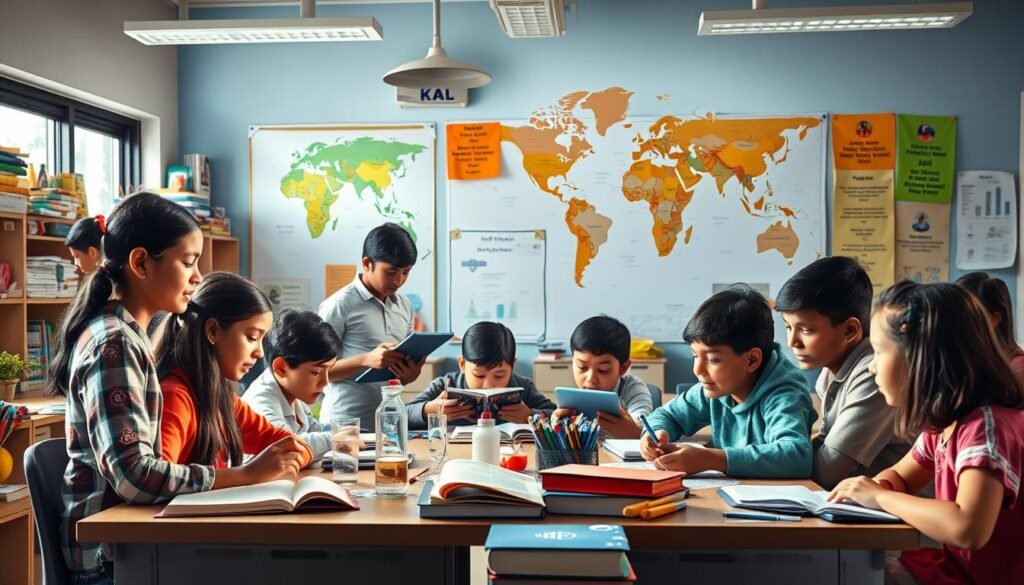
Facing Skill Gaps: Challenges in the Indian Employment Sector
India’s job market is struggling with skill gaps. This is a big problem in many industries. It shows we need to fix the system fast.
There are big differences in skills across the country. This makes it hard for everyone to get good training. Also, people often see vocational education as less important. This makes it harder to get people to learn new skills.
Identifying Barriers
There are big hurdles to overcome to build a skilled workforce. In 2022, India needed 103 million skilled workers but only had 74 million12. The healthcare sector is especially bad, with too few doctors and nurses12.
By 2030, we might face a skill gap of 23 million if we don’t act12. Skills like data analysis and coding are in demand but only 5% of workers have them12. This is bad for jobs and the economy.
To solve these problems, we need better teamwork between schools and companies. Right now, 90% of Indian companies struggle to find skilled workers13. Working together can make sure education meets job needs. Also, 66% of workers want their employers to help them learn new digital skills13.
Opportunities Through the Prime Minister’s Internship Scheme
The Prime Minister’s Internship Scheme is a big chance for students and recent graduates in India. It offers real-world experience in many fields. Started in the 2024 Union Budget, it aims to give internships to over 1 crore young people in five years.
This is a huge step forward for youth internship in India. It helps improve job skills and gets young people ready for the job market.
The scheme starts on December 2 with a goal to place 1.25 lakh interns in 24 sectors. These include oil, gas, energy, hospitality, and banking14. This will help interns and also build a skilled workforce for companies.
Those who qualify will get ₹5,000 a month and ₹6,000 extra for other costs15.
The Prime Minister’s Internship Scheme connects school learning with real-world needs. It will spend ₹800 crores on its first project. It aims to help in 737 districts across 36 states and union territories14.
When applications opened on October 12, 1,55,109 candidates signed up in 24 hours. This shows how eager young people are for industry experience14.
Big companies like Jubilant Foodworks, Maruti Suzuki India, and Reliance Industries are part of it. They want to help the youth14. The government plans to upskill 4.1 crore youths, showing its commitment to job readiness15.
Skill Development Programs India: Bridging the Gap
India is working hard to improve its skill development programs. These programs help people get jobs and prepare for changing job markets. They make sure you have the skills you need for your career.
Diverse Offerings
India’s skill development programs are diverse and aimed at improving job readiness. Every year, 4.75 million people join the workforce. Yet, only 4.7% have formal skills training, unlike Japan’s 80%16.
Programs like the Pradhan Mantri Kaushal Vikas Yojana (PMKVY) have trained over 1.42 crore people since 2015. This shows the government’s effort to increase vocational training17.
The Skill India Digital Hub has enrolled over 60 lakh learners. This shows a new way of learning in the digital age17. These programs teach both core and soft skills, preparing you for teamwork and changing job needs.
Upskilling and reskilling are key to a secure career. Industry-specific programs make skills more relevant and address unemployment16. There’s also a focus on getting more women involved, making training more inclusive17.
These programs target specific sectors, making workers more adaptable. The Ministry of Skill Development works with others to make sure training meets industry needs18.
Green Skills: Preparing for a Sustainable Economy
The world faces big environmental challenges, making green skills more important than ever in India. The Green Skill Development Programme (GSDP) is key in training workers for environmental conservation. It has identified 80 green skills needed for a low-carbon economy, training over 2 lakh candidates.
More than 60,000 people have found jobs in the environmental sector through GSDP. This shows the program’s success. The GSDP won the Future Policy Gold Award in 2019, showing it’s recognized globally19.
Emphasizing Environmental Awareness
India plans to reach a renewable energy goal of 450 GW by 2030. This could lead to a 30% increase in jobs in the sector20. The International Labour Organization (ILO) believes a green economy could add 3 million jobs in renewables in India by 203020.
The Skill Council for Green Jobs (SCGJ) has set up 44 approved qualifications. It has trained over 500,000 candidates, including 100,000 in solar and renewable energy20. SCGJ supports green businesses with over 4,000 trainers and assessors across the country20.
The Green Skill Development Program aims to train 7 million youth in environmental sectors21. It started with courses in biodiversity conservation and para-taxonomy. So far, 94 and 152 trainees have completed basic and advanced courses, respectively21.
These trainees have found jobs in conservation biology and project management. This shows the value of green workforce training. As the program grows, it will help India meet its sustainability goals and create more jobs21.
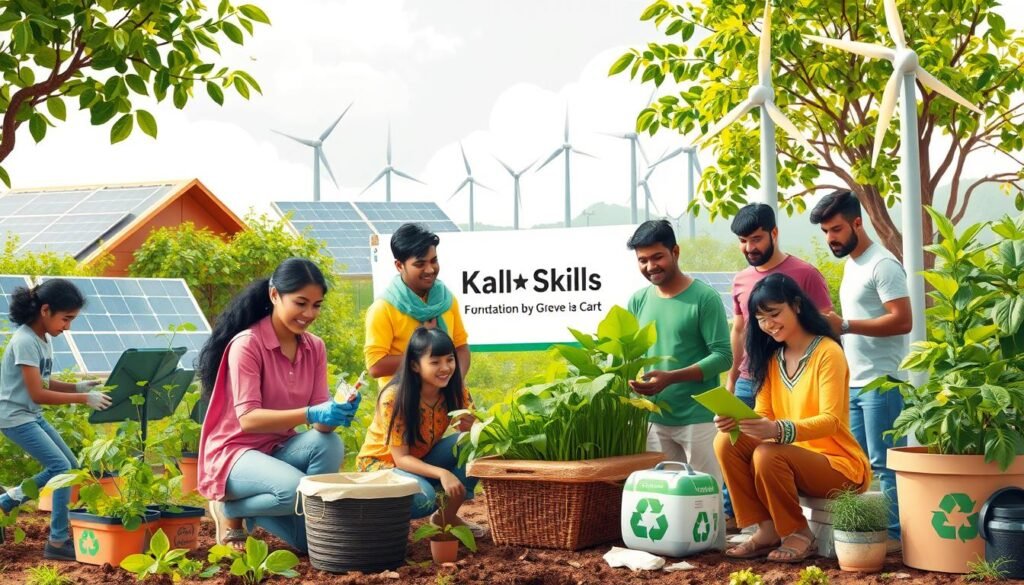
| Total Skills Identified | Trained Candidates | Job Placements | Award Recognition | Renewable Energy Target (GW) |
|---|---|---|---|---|
| 80 | Over 2 lakh | More than 60,000 | Future Policy Gold Award – 2019 | 450 |
Role of the Private Sector in Skill Development
The private sector plays a big role in skill development. It works closely with schools and government programs. This helps the workforce get the skills needed for jobs.
Companies offer training, internships, and other programs. These help young people get jobs. It shows the private sector cares about helping the community and solving the skills gap.
Collaborations and Contributions
The private sector is really committed to skill development. For example, JPMorgan Chase & Co. gave $10 million to help 37 million students in India. This is part of a bigger effort to help 90 million students and 4.5 million teachers.
The Government of India wants to skill 400 million people by 2022. This shows how much the private sector is needed in this area22.
Companies are using their resources to make training materials. JPMorgan’s $2 million grant is helping 1.6 million students. It could help more students across the country23.
Groups like the Logistics Sector Skill Council are training women for jobs. This has made things more efficient and cut down on turnover23.
There are programs for women and people with disabilities in rural areas. They are learning to be electric vehicle service technicians or 3D printing operators. Fresh graduates are getting apprenticeships in banking and insurance to get the skills they need23.
The private sector’s work is crucial. It helps the economy grow and improves lives in India. It’s especially important as over 12 million people join the workforce each year22.
Online Learning Platforms and Their Impact
Online learning platforms have changed education in India a lot. With schools closed due to the pandemic, about 73.8% of students worldwide were affected24. This shows we need new ways to learn fast. Tools like educational technology help students learn better, especially with good teachers25.
A New Era of Education
Online learning platforms meet many educational needs. Udemy saw more people taking courses in 3D design and programming, showing a focus on skills25. Sites like Coursera and edX offer millions of courses, helping people learn what they want26. They also help different learning styles, making education more accessible25.

Online courses are flexible, but they have challenges. Students in rural areas struggle with internet access, making learning hard24. Staying motivated and engaged online needs self-discipline and flexibility25. We must solve these problems to make online learning better.
| Platform | Features | Users/Reach | Focus Areas |
|---|---|---|---|
| Udemy | 220,000+ video lessons | Global | Diverse subjects including tech skills |
| Coursera | Courses, certifications, degrees | Over 86 million | Professional development |
| edX | Virtual courses | 86 million users | Higher education and professional skills |
| Moodle | Free and paid versions | Global | Education across all levels |
| Canvas | Main LMS for Ivy League | Universities and colleges | Comprehensive learning management |
| GeeksforGeeks | Content for students and professionals | Widely used | Programming and tech skills |
These online platforms help people learn all their lives, showing how important being adaptable is25. As education keeps changing, learning new skills will always be key for Indians.
Skilled India: Empowering Youth for Evolving Job Markets
The job market in India is always changing. With over 356 million young people, India has the world’s largest youth population. This is a big chance for growth and new ideas27. To keep up, we need to make sure young people have the right skills for the future.
Future-Oriented Skillsets
Young people need training in digital skills, critical thinking, and starting their own businesses. The Skill India program aims to train over 400 million people by 2022. This matches the fast-changing job market’s needs27. But, only about 2.3% of workers have formal skills, showing a big gap to fill27.
It’s important to make young people more employable. Studies show that government training programs help graduates find jobs28. Programs like PMKVY have trained over 10 million people, showing India’s dedication to skilled youth27. Adding soft skills training has also made new workers perform better at their jobs28.
As jobs change, schools, businesses, and government must work together. They need to create training that meets local needs and keeps up with technology. This way, we can raise a generation of young people who are ready for today’s jobs and help India’s economy grow.
Vocational Training and its Importance
Vocational training is key in filling the skills gap in India. It helps people improve their job chances by learning practical skills. The National Education Policy (NEP) 2020 highlights the importance of vocational education, making sure it meets job market needs29.
Focusing on Practical Skills
Vocational training lets students learn by doing, gaining essential skills not always covered in school. This hands-on approach boosts job readiness, preparing students for the workforce30. Plus, vocational education can lead to well-paying jobs, with salaries from INR 1 LPA to INR 23 LPA30.
Starting vocational training early helps students discover different career paths. This approach keeps students interested and reduces dropout rates by making learning relevant29. It also reduces the need for foreign workers, helping local jobs and economic stability30.

Regional Disparities in Skill Development
India struggles with big gaps in skill development across different areas. Rural areas face the biggest challenges, with less access to training and resources. This makes it hard for people to get the skills needed for today’s jobs.
Between 2017 and 2022, over 80 million jobs were created. The Labor Force Participation Rate (LFPR) in 2022-23 was 61.6%, showing a lot of untapped talent31. With 22.15% of the workforce at Skill Level 1, there’s a clear need for better skill development efforts31.
Addressing Inequalities
To fix these skill gaps, we need to make sure everyone has a chance to learn. Different states have different needs, so we must tailor our efforts. The demand for skilled workers is growing in areas like cars, buildings, and clothes32.
Boosting the LFPR among those with diploma or certificate courses is key, especially in rural areas31 and32. We also need to work together, with government and international programs. This includes efforts like NSDC International to help local communities33.
| Skill Level | Percentage of Workforce |
|---|---|
| Level 1 (Low-skilled) | 22.15% |
| Level 2 (Semi-skilled) | 66.89% |
| Level 3 (Skilled) | 2.37% |
| Level 4 (Highly Skilled) | 8.59% |
Collaboration Between Educational Institutions and Industries
Working together, schools and industries make sure training meets job market needs. This teamwork helps make sure students are ready for the workforce. It makes graduates more employable.
Aligning Training with Industry Needs
India has over 1.425 billion people, with 600 million under 25. This is a big chance for India to become a global talent hub34. By involving industry experts in training, students learn what employers expect34.
Partnerships with industries help mix academic skills with real-world knowledge. This way, graduates can make a difference right away34.
The National Education Policy 2020 supports partnerships with foreign schools. It leads to new programs and research, making training better34. The UGC’s “professor of practice” roles bring industry know-how into classrooms34.
India’s education sector is set to hit US$ 225 billion by FY2535. Schools need to keep up with the market by updating their courses. They must work closely with industries to make sure training matches job needs.
By 2025, over 50% of workers worldwide will need new skills to keep their jobs36. This shows how crucial it is for schools to focus on skills that employers want. Currently, only 48.7% of graduates find jobs, as the India Skills Report 2023 shows36.
Programs like Pradhan Mantri Kaushal Vikas Yojana aim to skill 10 million youth by 2025. This shows the government’s support for making students industry-ready through teamwork36.
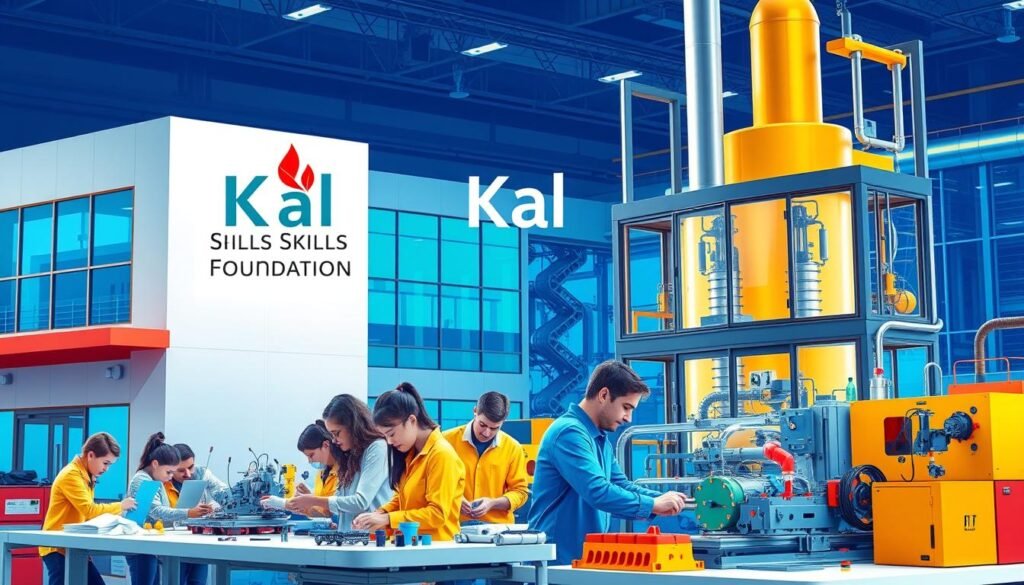
International Cooperation for Skill Development
International cooperation boosts skill development in India by sharing global best practices. It involves partnerships with other countries for mutual benefit. These partnerships lead to skill exchange programs that enhance workforce skills.
Global Perspectives
The Ministry of Skill Development and Entrepreneurship (MSDE) has made 11 agreements with countries like Australia and Germany. These agreements aim to improve vocational education in India37. The National Skill Development Corporation (NSDC) has also made 18 agreements with countries like Japan and Canada. These agreements help with recruitment and training services37.
Australia plans to recruit 100 skilled Indian workers for various jobs, aiming to increase to 620 roles37. India and Germany are working together on vocational education projects until October 202337.
Japan has sent 424 technical interns and is preparing 738 more for future roles37. The TEJAS program by NSDCI focuses on placing Indian workers in GCC countries, with 3,484 confirmed jobs37.
These partnerships help upgrade local training institutions. The Government of India is improving over 2,000 training institutes and colleges38. Projects like ‘Support for Skills Development in India’ have helped improve vocational education quality38.
Conclusion
Reflecting on Skilled India, it’s clear that making the workforce skilled is key for the future. Skill development shows that while programs like PMKVY have trained millions, there are still big challenges. These include the quality of training and reaching rural areas3940.
Also, there’s a big gap between the skills people have and what jobs need. This highlights the need for everyone to work together. This includes the government, industries, and schools4140.
Looking to the future, it’s crucial for all to join forces to make people more employable. By focusing on better skill development and training, India can close the gap between education and jobs. This will help India’s economy grow strong4140.
The path to a skilled India is not just about vocational training. It’s about making sure everyone has the skills needed for tomorrow’s challenges.
FAQ
What is the Skilled India initiative?
Why is skill development important for the Indian economy?
What are the major challenges facing the skilled workforce in India?
What government programs promote skill development in India?
How does the National Education Policy 2020 contribute to skill development?
What is the Prime Minister’s Internship Scheme?
How do online learning platforms impact skill acquisition in India?
What role does the private sector play in skill development?
What are green skills and why are they important?
How can collaboration improve skill development?
Source Links
- Skill India Mission – Towards Empowering the Nation’s Workforce – https://dolcevitaadvisors.com/skill-india-mission-empowering-nations-workforce/
- NSDC and SHRM Collaborate to Empower India’s Workforce for a Skilled Future – https://cxotoday.com/press-release/nsdc-and-shrm-collaborate-to-empower-indias-workforce-for-a-skilled-future/
- IMPORTANCE OF SKILL DEVELOPMENT IN INDIA – https://www.linkedin.com/pulse/importance-skill-development-india-olivegreen-consulting
- PDF – https://ijrep.com/wp-content/uploads/2019/02/31-33-SKILL-DEVELOPMENT-IN-INDIA.pdf
- The Power Of Skill Development: Empowering Indian Youth For Success – https://www.educationnext.in/posts/the-power-of-skill-development-empowering-indian-youth-for-success
- The Skill Development Landscape in India and Implementing Quality Skills Training – https://www.bwp-zeitschrift.de/dokumente/pdf/IMaCS.pdf
- Transforming Education and Skill Development in India – https://skilline.ai/blogs/navigating-indias-skills-landscape-how-to-close-the-skill-gap/
- Navigating India’s Skill Landscape – https://pib.gov.in/PressReleasePage.aspx?PRID=2053796
- New Initiative to Support ‘Skilled India’ Vision – OpenGov Asia – https://opengovasia.com/2024/09/09/new-initiative-to-support-skilled-india-vision/
- New Education Policy 2020: Purpose, Features, Implementation – https://www.learningroutes.in/blog/new-education-policy-2021-things-you-need-to-know
- About National Education Policy | Government of India, Ministry of Education – https://www.education.gov.in/nep/about-nep
- How India can bridge talent and skill gaps in key emerging sectors – ET Manufacturing – https://manufacturing.economictimes.indiatimes.com/news/industry/how-india-can-bridge-talent-and-skill-gaps-in-key-emerging-sectors/112585703
- Bridging the skills gap: Fuelling careers and the economy in India – https://impact.economist.com/perspectives/talent-education/bridging-skills-gap-fuelling-careers-and-economy-india
- PM Internship Scheme 2024 – https://pminternshipscheme.com/
- Prime Minister’s Internship Scheme: Shaping India’s Future Workforce – https://www.linkedin.com/pulse/prime-ministers-internship-scheme-shaping-indias-future-rkzfc
- Bridging the Skills Gap in India with Skill Development Programs – https://www.linkedin.com/pulse/bridging-skills-gap-india-skill-development-programs-et8rc
- PDF – https://static.pib.gov.in/WriteReadData/specificdocs/documents/2024/sep/doc2024911392001.pdf
- From local talent to global force: Bridging the skills gap for India’s overseas workforce – https://www.grantthornton.in/insights/media-articles/from-local-talent-to-global-force-bridging-the-skills-gap-for-indias-overseas-workforce/
- Green skill development programme in India – https://timesofindia.indiatimes.com/blogs/voices/green-skill-development-programme-in-india/
- India’s Skill Council for Green Jobs – Policies – IEA – https://www.iea.org/policies/17819-indias-skill-council-for-green-jobs
- Green Skill Development Programme – https://www.gsdp-envis.gov.in/
- How the Private Sector Develops Skills: Lessons from India – https://www.undp.org/policy-centre/istanbul/publications/how-private-sector-develops-skills-lessons-india
- Private sector comes on board to upgrade the skills of India’s youth – https://blogs.worldbank.org/en/endpovertyinsouthasia/private-sector-comes-board-upgrade-skills-indias-youth
- Students’ perception and preference for online education in India during COVID -19 pandemic – https://www.ncbi.nlm.nih.gov/pmc/articles/PMC7836920/
- Overcoming common challenges in online learning with edtech – https://www.indiatoday.in/education-today/featurephilia/story/overcoming-common-challenges-in-online-learning-with-edtech-2622332-2024-10-24
- Online Learning Platforms: The Different Types And Their Benefits – https://www.forbes.com/advisor/education/career-resources/online-learning-platforms/
- Skill India: Empowering Youth with Market-Relevant Skills – https://www.linkedin.com/pulse/skill-india-empowering-youth-market-relevant-skills-murugan-9lixc
- CUET : Blog Detail – https://www.drishticuet.com/blog/detail/youth-skill-development-for-a-brighter-future
- The Importance of Vocational Education in the Indian K-12 Education System – https://www.linkedin.com/pulse/importance-vocational-education-indian-0fnac
- Skills That Shape Careers: The Importance of Vocational Training In India For Students – https://theunitedindian.com/news/blog?Vocational-Training-In-India-For-Students&b=178&c=2
- India:The Skills Gap Challenge | SRIRAMs IAS – https://www.sriramsias.com/upsc-daily-current-affairs/indiathe-skills-gap-challenge/
- Microsoft Word – Document1 – https://www.gjimt.ac.in/web/wp-content/uploads/2017/10/Sakshi-Sethi-Esha-Sharma_Skill-Development-Opportunities-Challenges-in-India.pdf
- From local talent to global force: Bridging the skills gap for India’s overseas workforce – ET Government – https://government.economictimes.indiatimes.com/blog/from-local-talent-to-global-force-bridging-the-skills-gap-for-indias-overseas-workforce/110945617
- Industry-university links are key to fulfilling India’s vast potential – https://www.timeshighereducation.com/blog/industry-university-links-are-key-fulfilling-indias-vast-potential
- Education in India: Higher Education Trends & Index | IBEF – https://www.ibef.org/industry/education-sector-india
- From Education to Employment: India’s Skill Development Push – Elets Digital Learning – https://digitallearning.eletsonline.com/2024/09/from-education-to-employment-indias-skill-development-push/
- International Collaborations | Ministry of Skill Development and Entrepreneurship – https://www.msde.gov.in/en/reports-documents/Skill-Engagements/International-Collaborations
- Support for Skills Development – https://www.giz.de/en/worldwide/16905.html
- Advantages and Disadvantages of Skill India – Talentedge – https://talentedge.com/articles/advantages-disadvantages-skill-india/
- Skill India: Education to Employment Bridge – https://www.investindia.gov.in/team-india-blogs/skill-india-education-employment-bridge
- Skill India: Challenges, Solutions, & Government Schemes – https://www.nextias.com/blog/skill-india/
